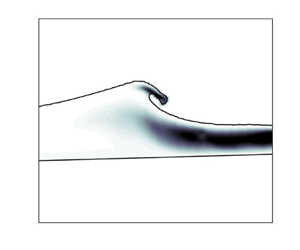Article contents
Reynolds stress turbulence modelling of surf zone breaking waves
Published online by Cambridge University Press: 22 February 2022
Abstract

Computational fluid dynamics is increasingly used to investigate the inherently complicated phenomenon of wave breaking. To date, however, no single model has proved capable of accurately simulating the breaking process across the entirety of the surf zone for both spilling and plunging breakers. The present study newly considers the Reynolds stress– $\omega$ turbulence closure model for this purpose, where
$\omega$ turbulence closure model for this purpose, where  $\omega$ is the specific dissipation rate. Novel stability analysis proves that, unlike two-equation closures (at least in their standard forms), the stress–
$\omega$ is the specific dissipation rate. Novel stability analysis proves that, unlike two-equation closures (at least in their standard forms), the stress– $\omega$ model is neutrally stable in the idealized potential flow region beneath surface waves. It thus naturally avoids unphysical exponential growth of turbulence prior to breaking, which has plagued numerous prior studies. The analysis is confirmed through simulation of a progressive surface wave train. The stress–
$\omega$ model is neutrally stable in the idealized potential flow region beneath surface waves. It thus naturally avoids unphysical exponential growth of turbulence prior to breaking, which has plagued numerous prior studies. The analysis is confirmed through simulation of a progressive surface wave train. The stress– $\omega$ model is then applied to simulate a turbulent wave boundary layer, demonstrating superior accuracy relative to a two-equation model, especially during flow deceleration. Finally, the stress–
$\omega$ model is then applied to simulate a turbulent wave boundary layer, demonstrating superior accuracy relative to a two-equation model, especially during flow deceleration. Finally, the stress– $\omega$ model is employed to simulate spilling and plunging breaking waves, with seemingly unprecedented accuracy. Specifically, the present work marks the first time that a single turbulence closure model collectively: (1) avoids turbulence over-production prior to breaking, (2) accurately predicts the breaking point, (3) provides reasonable evolution of turbulent normal stresses, while also (4) yielding accurate evolution of undertow velocity structure and magnitude across the surf zone, for both spilling and plunging cases. Differences in the predicted Reynolds shear stresses (hence flow resistance) are identified as key to the improved inner surf zone performance, relative to a state-of-the-art two-equation model.
$\omega$ model is employed to simulate spilling and plunging breaking waves, with seemingly unprecedented accuracy. Specifically, the present work marks the first time that a single turbulence closure model collectively: (1) avoids turbulence over-production prior to breaking, (2) accurately predicts the breaking point, (3) provides reasonable evolution of turbulent normal stresses, while also (4) yielding accurate evolution of undertow velocity structure and magnitude across the surf zone, for both spilling and plunging cases. Differences in the predicted Reynolds shear stresses (hence flow resistance) are identified as key to the improved inner surf zone performance, relative to a state-of-the-art two-equation model.
- Type
- JFM Papers
- Information
- Copyright
- © The Author(s), 2022. Published by Cambridge University Press
References
REFERENCES
- 16
- Cited by





